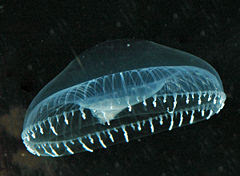Viruses are nasty opponents, as anyone who has followed the battles against influenza, SARs and HIV/AIDS can attest. They are diverse and in many cases evolve at rates that confound efforts to contain them. Anyone who has gotten a flu shot, and then came down with the flu a few months later because the “strain” of virus that the vaccine was not the same as the “strain” that they were infected with, knows just how fast viruses can evolve. In many cases, medical professional never really know which virus has caused the symptoms in their patients, and this complicates treatment and often leads to the misuse of antibiotics, which, of course, are never effective against viruses.
At the ScienceWriters 2008 New Horizons in Science meeting at Stanford University (sponsored by CASW) this week, Dr. Joseph DeRisi of UCSF presented an interesting talk on his research to develop a new form of “chip” as a diagnostic tool for identifying the viral contributions to diseases. Gene chips are often used by molecular biologists to determine the relationship between a gene and an observed condition. Dr DeRisi's work takes this approach one step further.
What is interesting here is Dr. DeRisi’s application of evolutionary genomics to his work. Like microbiologists, virologists recognize that they have only identified a small fraction of the diversity of viruses that are out there in the natural world. Despite advances in sequencing technology, the ability to sequence every virus in a given environment, such as a fecal or nasal sample, is still not cost effective. However, what Dr DeRisi has done is to develop a “viral chip” that contains not the entire sequences of every virus, but rather the sequences of key genes that are evolutionarily important to certain families of viruses. When one of these viral chips is exposed to a sample, a computer program determines the level of similarity between the DNA (or RNA) in a virus and the sequence on the chip. For previously unknown viruses, this can allow a quick classification of the virus to a certain group, and has been proven to be very successful by Dr. DeRisi’s team in diagnosing diseases for which no known cause could be determined by diagnostic tools.
Furthermore, Dr DeRisi has proposed making these chips available at cost to the medical community through a non-profit organization. The availability of a new technology at an inexpensive cost would represent an important new development in the war against viruses, and would rapidly generate an increase in data for public health officials.
Additional Links
DeRisi Lab at UCSF




